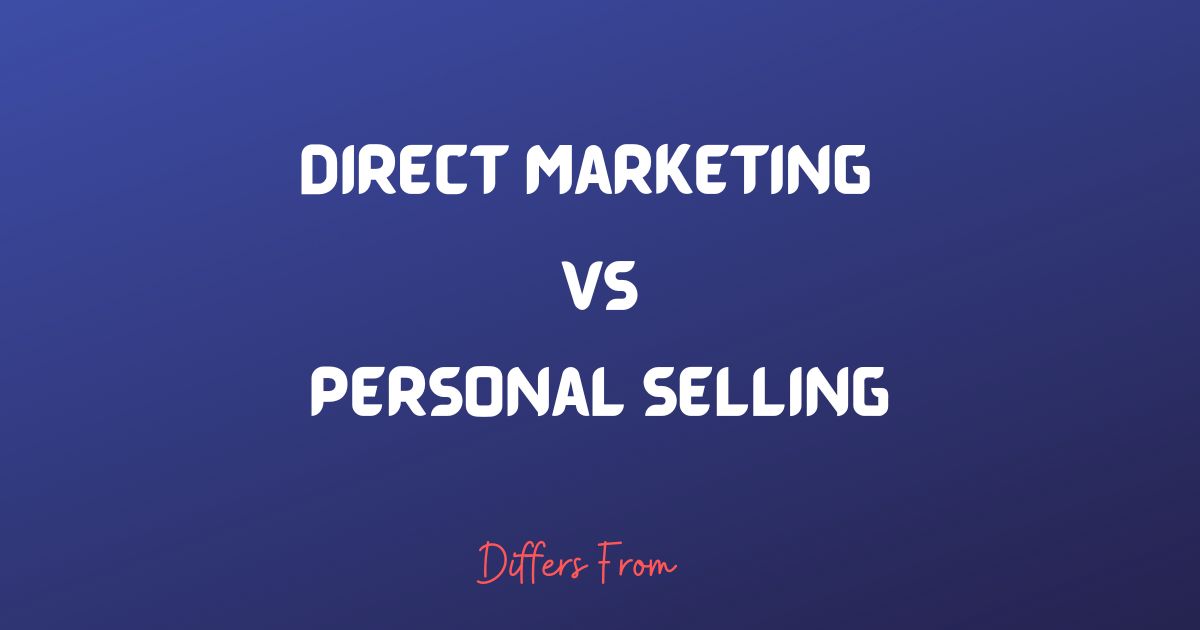In today’s rapidly evolving business landscape, understanding the difference between direct marketing and personal selling is crucial. This blog delves deep into these two essential strategies, providing insights into their unique approaches, advantages, and when to use each method. Let’s explore how these dynamic marketing techniques can drive success for your business.
What is direct marketing?
Direct marketing is a marketing strategy that involves communicating directly with individuals or businesses to promote products or services.
It typically employs channels such as direct mail, email marketing, telemarketing, or targeted advertising. According to a study by the Data & Marketing Association, in 2020, direct mail achieved a response rate of 4.9% for prospect lists and 9% for house lists, outperforming digital channels.
Direct marketing allows businesses to reach specific audiences and establish a personalized connection, enhancing the chances of generating leads and sales.
What is personal selling?
Personal selling is a face-to-face or direct communication approach used by sales representatives to persuade potential customers to purchase products or services.
It involves building relationships, addressing customer needs, and providing tailored solutions. According to a study by Statista, in 2020, personal selling accounted for $464 billion in sales in the United States.
Personal selling allows for direct interaction, customization, and immediate feedback, enabling salespeople to effectively communicate product benefits and overcome objections, leading to increased sales and customer satisfaction.
Difference between direct marketing and personal selling
| Direct Marketing | Personal Selling | |
| Communication Channels | Utilizes channels like direct mail, email, telemarketing, targeted advertising, and online marketing. | Involves direct, personal interaction between salesperson and customer. |
Reach | Targets a broader audience simultaneously, regardless of their location. | Focuses on establishing long-term relationships and fostering customer loyalty. |
| Personalization | Offers the ability to personalize messages based on customer data and preferences. | Tailors solutions to meet specific customer needs and addresses objections in real-time. |
| Cost-Effective | Eliminates the need for extensive travel or face-to-face interactions, reducing expenses. | Allows for hands-on demonstrations of products or services. |
| Measurement and Analytics | Provides robust tracking and measurement of campaign performance. | Provides real-time feedback from customers, aiding in adjusting sales approach. |
| Mass Communication | Tailors solutions to meet specific customer needs and addresses objections in real-time. | Builds trust and rapport through personal connections and understanding customer needs. |
| Targeted Audience | Allows businesses to target specific demographics, interests, or purchasing behaviors. | Particularly effective for complex or high-value sales that require in-depth product knowledge. |
| Response Rates | Can achieve significant response rates, such as direct mail’s 4.9% for prospect lists and 9% for house lists. | Delivers messages to many potential customers at once. |
what is direct marketing – personal selling?
Comparison between direct marketing and personal selling
Direct Marketing and Personal Selling are two distinct approaches to reaching and engaging with potential customers, each with its advantages and characteristics.
Direct Marketing utilizes various communication channels like direct mail, email, telemarketing, targeted advertising, and online marketing to target a broad audience regardless of location. It emphasizes personalization by tailoring messages based on customer data and preferences and offers cost-effective methods by eliminating the need for extensive travel or face-to-face interactions. This approach is highly measurable, providing robust tracking and analytics for campaign performance. It excels at mass communication, delivering messages to many potential customers at once, and achieving significant response rates.
On the other hand, Personal Selling involves face-to-face interactions between a salesperson and a customer, focusing on relationship building and trust. It customizes solutions to meet specific customer needs, particularly effective for complex or high-value sales. Personal selling provides immediate feedback, enabling real-time adjustments in the sales approach, and allows for hands-on product or service demonstrations. The salesperson plays a crucial role as a decision influencer, building trust and rapport through personal connections and understanding customer needs.
In summary, Direct Marketing is more geared toward broad, personalized mass communication with cost-effective advantages and high response rates, while Personal Selling emphasizes building relationships, customizing solutions, and providing immediate feedback to influence customer decisions, making it particularly effective for complex or high-value sales. The choice between these two approaches depends on the nature of the product or service, the target audience, and the business’s overall marketing strategy.
Direct Marketing:
Pros of Direct Marketing:
- Targeted Reach: Direct marketing allows you to reach specific audiences interested in your product or service.
- Personalization: Messages can be tailored to individual customer preferences, increasing relevance.
- Measurable Results: You can track and measure the performance of your campaigns with precision.
- Cost-Efficiency: It’s often more cost-effective than traditional advertising, reducing expenses.
- Quick Response: Direct marketing can generate fast customer responses, facilitating timely sales.
Cons of Direct Marketing:
- Intrusiveness: Some customers may find direct marketing methods intrusive or spammy.
- Information Overload: Customers may receive too many marketing messages, leading to message fatigue.
- Data Privacy Concerns: Handling customer data requires compliance with privacy regulations.
- Creative Limitations: Certain direct marketing methods have limited space for creativity.
- Response Variability: Response rates can vary and may not always meet expectations.
What is an example of direct marketing?
An example of direct marketing is sending personalized email campaigns to a targeted list of potential customers, promoting a product or service, and encouraging a specific action, like making a purchase or signing up for a newsletter.
Personal Selling
Pros of Personal Selling:
- Relationship Building: Personal selling allows for the development of strong, one-on-one relationships with customers.
- Customization: Salespeople can tailor their approach to address specific customer needs and objections.
- Immediate Feedback: Salespeople can gather real-time feedback from customers, allowing for quick adjustments in the sales process.
- Trust and Rapport: Personal interactions help build trust and rapport, which can be crucial in complex sales situations.
- Decision Influencer: Salespeople have the ability to directly influence customer decisions through persuasive and consultative approaches.
Cons of Personal Selling:
- Cost-Intensive: Personal selling often involves significant costs, including salaries, training, and travel expenses.
- Limited Reach: It’s not as effective for reaching a large, geographically dispersed audience as other marketing methods.
- Time-Consuming: Building relationships and making sales through personal selling can be time-consuming.
- Dependence on Salespeople: The success of personal selling is highly dependent on the skills and performance of individual salespeople.
- Resistance: Some customers may be resistant to in-person sales interactions and prefer more autonomous shopping experiences.
What are some examples of personal selling?
Examples of personal selling include a salesperson giving a product demonstration at a customer’s home, a car salesperson helping a customer choose a vehicle, or a financial advisor offering one-on-one investment advice.
FAQs
Is Facebook a form of direct marketing?
Yes, Facebook can be used as a platform for direct marketing when businesses create targeted ads to reach specific audiences with personalized messages and calls to action.
Is WhatsApp a form of direct marketing?
WhatsApp can be used for direct marketing by businesses to send personalized messages, offers, or customer support directly to customers, making it a form of direct communication.
What are the three elements of direct marketing?
The three key elements of direct marketing are target audience segmentation, personalized messaging, and a clear call to action.
What are the four pillars of direct marketing?
The four pillars of direct marketing typically include targeting the right audience, offering a compelling offer or message, providing an easy way for customers to respond, and measuring and analyzing the results for continuous improvement.
What is a direct marketing strategy?
A direct marketing strategy is a plan that outlines how a business will use various channels, such as email, direct mail, or online advertising, to reach a specific audience with personalized messages to achieve marketing and sales objectives.
What are the main methods of direct marketing?
The main methods of direct marketing include email marketing, direct mail, telemarketing, online advertising, social media advertising, and mobile marketing.
What are the three types of personal selling?
The three types of personal selling are inside sales (phone or online sales), outside sales (in-person sales meetings), and key account sales (managing large and strategic customer accounts).
What is a personal selling strategy?
A personal selling strategy is a plan that outlines how a salesperson will engage with customers to build relationships, address their needs, and ultimately sell products or services.
What are the seven steps of personal selling?
The seven steps of personal selling typically include prospecting, pre-approach, approach, presentation, handling objections, closing the sale, and follow-up.
What is the difference between personal selling and non-personal selling?
Personal selling entails one-on-one interactions between a salesperson and a customer, emphasizing relationship-building and customization. Non-personal selling refers to methods like advertising or direct marketing that do not involve direct, face-to-face interactions. The key distinction is the level of personal engagement and interaction in the sales process.
What is the difference between direct selling and online selling?
Direct selling typically involves selling products directly to consumers outside of a fixed retail location, often through in-home product demonstrations or party plans. Online selling, on the other hand, refers to the sale of products through e-commerce websites. The primary difference is in the sales channel, with direct selling often emphasizing personal interactions, while online selling is conducted over the internet.
Conclusion
Direct marketing relies on targeted mass communication through various channels, while personal selling involves face-to-face interactions to build relationships and influence individual customers. Both approaches have distinct strengths in reaching and engaging with potential customers.

